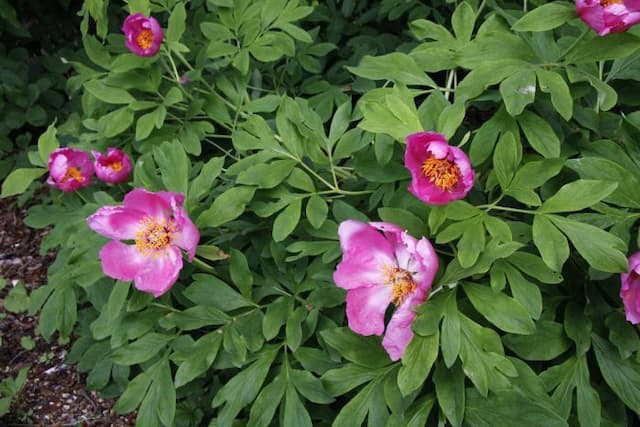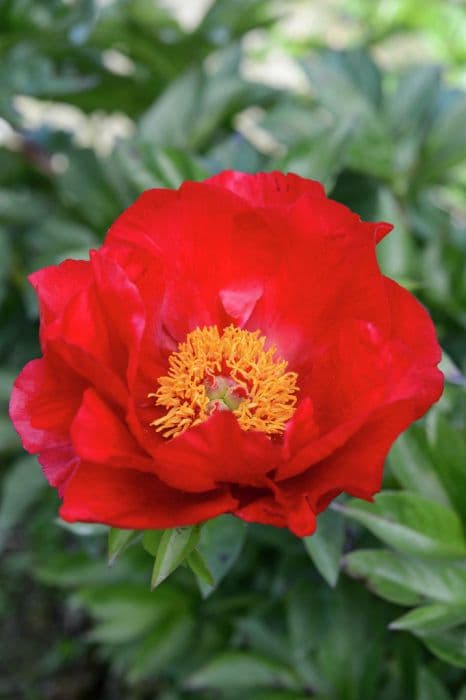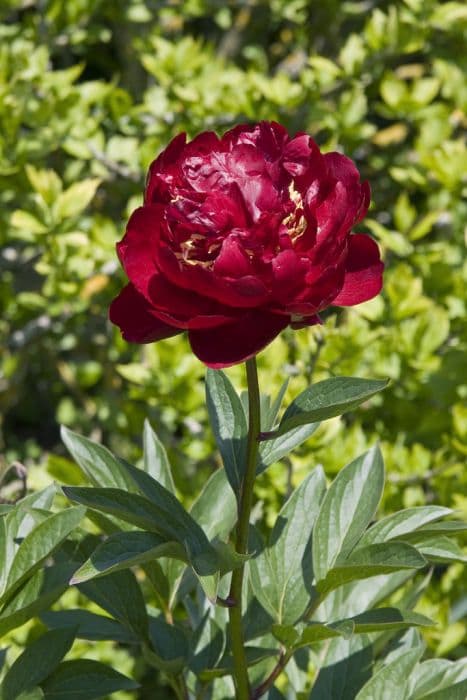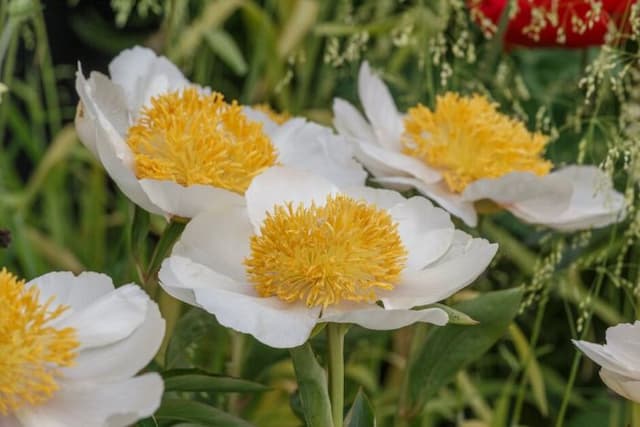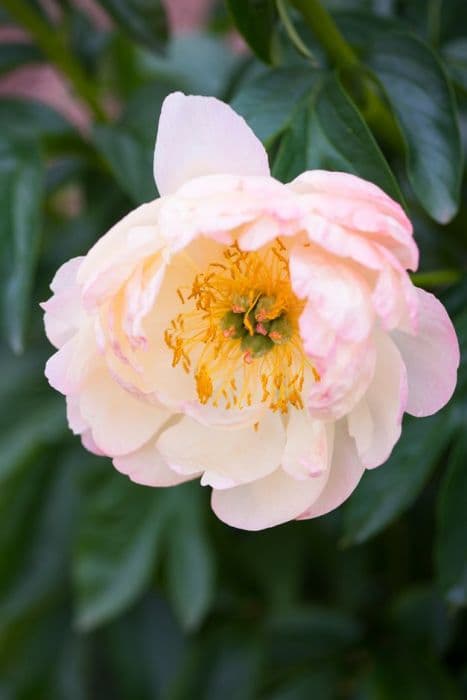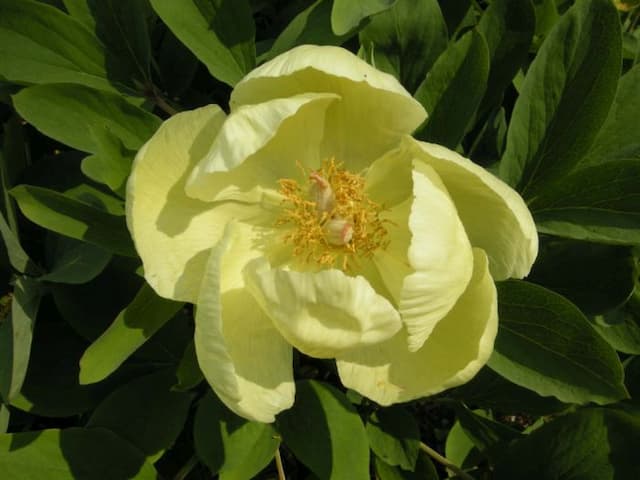Himalayan Peony Paeonia emodi

ABOUT
Paeonia emodi, commonly known as Himalayan peony, is a perennial plant celebrated for its strikingly beautiful flowers. The plant boasts large blooms that usually come in white or a soft pink shade, which may be single, semi-double, or fully double in form with each flower comprising numerous petals that enfold delicately around a center of golden-yellow stamens. These flowers exude a captivating fragrance that lures in garden visitors and pollinators alike. The Himalayan peony's foliage is an attractive deep green color, divided into leaflets that are gracefully spread outwards, forming an elegant bushy appearance. The leaves may exhibit a slightly serrated edge adding to their textural quality. As a part of its growth cycle, the plant dies back to the ground in winter, with new sprouts emerging from the soil in spring, building anticipation for the luscious blooms that follow in the growing season.
About this plant
 Names
NamesFamily
Paeoniaceae
Synonyms
Himalayan Peony, White Peony
Common names
Paeonia emodi Wall. ex Royle, Paeonia corallina Retz.
 Toxicity
ToxicityTo humans
The plant Paeonia emodi, known commonly as the Himalayan peony, is not typically regarded as highly toxic to humans. However, as with many plants, ingesting large quantities or certain parts of the plant may potentially cause mild stomach upset or an allergic reaction in some individuals. The symptoms of an allergic reaction may include itching, swelling, or difficulty breathing, which would require immediate medical attention. There is limited information on the severe toxicity of this specific peony species through ingestion, but generally, peonies are not considered highly poisonous to humans.
To pets
The Himalayan peony (Paeonia emodi) is considered to be only mildly toxic to pets such as dogs and cats. If ingested, it may cause mild gastrointestinal upset, including symptoms like vomiting or diarrhea. It's important to note that while the toxicity is generally low, individual pets can react differently, and some may be more sensitive to the plant's compounds. If you suspect your pet has consumed a significant amount of the plant and is showing adverse symptoms, it is recommended to consult your veterinarian.
 Characteristics
CharacteristicsLife cycle
Perennials
Foliage type
Deciduous
Color of leaves
Green
Flower color
White
Height
2-3 feet (0.6-0.9 meters)
Spread
2-3 feet (0.6-0.9 meters)
Plant type
Herb
Hardiness zones
5
Native area
Himalayas
Benefits
 General Benefits
General Benefits- Ornamental Value: Paeonia emodi, commonly known as Himalayan Peony, is often grown for its attractive, large, and showy flowers that can enhance the aesthetic appeal of gardens and landscapes.
- Cultural Significance: Himalayan Peony has been treasured in various cultures for centuries, symbolizing wealth, honor, and the beauty of nature, thus enriching the cultural heritage of gardens and public spaces.
- Biodiversity Support: As a native plant in various regions, it provides a suitable habitat and food source for pollinators like bees, butterflies, and birds, contributing to ecosystem health and biodiversity.
- Erosion Control: The plant’s root system can help stabilize soil and prevent erosion on slopes and banks, thus providing an ecological benefit in certain landscapes.
- Seasonal Interest: The Himalayan Peony offers seasonal interest with its spring blooms and lush, green foliage that can change color in the autumn, adding variety to seasonal plant displays.
 Medical Properties
Medical Properties- Analgesic: Paeonia emodi has been traditionally used for its pain-relieving properties.
- Anti-inflammatory: The plant contains compounds that may help reduce inflammation.
- Antioxidant: It is believed to possess antioxidant properties, helping to combat oxidative stress.
- Antispasmodic: It is used to alleviate muscle spasms and cramps.
- Sedative: Components of this plant are said to have a calming effect on the nervous system.
- Immunomodulatory: Paeonia emodi may influence immune system function.
 Air-purifying Qualities
Air-purifying QualitiesThis plant is not specifically known for air purifying qualities.
 Other Uses
Other Uses- Paeonia emodi, commonly known as Himalayan Peony, is sometimes used in landscaping as a decorative plant due to its large, fragrant blossoms and attractive foliage.
- The petals of the Himalayan Peony can be used to create a natural dye for textiles, providing a range of pink to purple hues.
- Dried petals of the plant can be incorporated into potpourri mixes for home fragrance due to their pleasant scent.
- Himalayan Peony seed oil, extracted from the seeds, is sometimes used in high-end cosmetic products for its emollient properties.
- The plant is involved in cultural and ceremonial events in some regions, such as weddings, where the flowers can be used for decoration or making bridal bouquets.
- Gardeners sometimes use the dried seed pods of the Himalayan Peony in flower arrangements to add an exotic and artistic touch.
- Himalayan Peony can sometimes act as a natural pest repellent in gardens due to its specific fragrance that deters certain insect pests.
- Floral artisans might use the dramatic blooms of the Himalayan Peony in the art of flower pressing, exploiting their vibrant colors and large petal size.
- The blossoms of the Himalayan Peony may be used as a natural ingredient in perfumery to capture its unique, fresh floral scent.
- In some cultures, the Himalayan Peony is a symbol of prosperity and happiness and is used as a motif or pattern in art, fabric design, and traditional crafts.
Interesting Facts
 Feng Shui
Feng ShuiPeony is often used in Feng Shui to attract love and romance; thus, placing peonies or imagery of them in the southwest corner of the home or bedroom can enhance these aspects in one's life.
 Zodiac Sign Compitability
Zodiac Sign CompitabilityThe Peony is not used in astrology practice.
 Plant Symbolism
Plant Symbolism- Honor: In many cultures, the common name Peony is associated with honor and high value, reflecting the esteem with which the flower is held due to its large, full blooms and rich fragrance.
- Beauty: Peonies, including Paeonia emodi, are often considered a symbol of beauty and are commonly used in gardens and floral arrangements to enhance aesthetic appeal.
- Prosperity: The fullness and numerous petals of the Peony can symbolize abundance and prosperity, making it a popular choice for celebratory occasions.
- Romance: As a popular wedding flower, Peonies are thought to represent love and are often associated with romantic relationships and marital bliss.
- Good Fortune: In some traditions, Peonies are believed to bring good luck and are seen as an auspicious symbol in various aspects of life, including wealth and success.
 Water
WaterHimalayan peony requires even moisture, especially during the growing season. Water the plant deeply once a week, providing about one to two gallons per plant to ensure the soil is moist but not waterlogged. During periods of drought or extreme heat, increase the frequency to twice a week. It is crucial not to overwater, as this can lead to root rot. Ensure that the soil drains well so the roots are not sitting in water.
 Light
LightHimalayan peony thrives in full sun to partial shade. The ideal spot for this plant is where it can receive at least six hours of sunlight per day. However, in hotter regions, provide some afternoon shade to protect the plant from intense heat.
 Temperature
TemperatureHimalayan peony prefers moderate temperatures and can tolerate a range between 65 to 75 degrees Fahrenheit as ideal growing conditions. They are hardy and can survive minimum winter temperatures down to around -20 degrees Fahrenheit. To ensure good health and bloom, avoid exposure to temperatures above 85 degrees Fahrenheit for prolonged periods.
 Pruning
PruningPrune your Himalayan peony in the fall after the leaves have died back to remove any dead or diseased foliage and to maintain plant health. Cut the stems down to within a few inches of the ground. Pruning helps to stimulate growth and ensures a robust plant for the next flowering season.
 Cleaning
CleaningAs needed
 Soil
SoilHimalayan peony (Paeonia emodi) thrives best in well-draining, fertile soil with a neutral pH around 6.5 to 7.5. A mix of loam, peat moss, and coarse sand in equal proportions serves as an excellent soil base. Adding organic compost to the mix will enrich the nutrient content, benefitting the plant's health and blooming capability.
 Repotting
RepottingHimalayan peony typically doesn't require frequent repotting and can be done every 3 to 4 years. These plants prefer to be undisturbed, so repot only when necessary, such as when the plant outgrows its container or the soil becomes depleted of nutrients.
 Humidity & Misting
Humidity & MistingHimalayan peonies prefer average to slightly above average humidity levels in their growing environment, but they can tolerate a range of humidity conditions. They are generally adaptable to the ambient humidity found in most temperate outdoor gardens.
 Suitable locations
Suitable locationsIndoor
Place Himalayan peony by a sunny window.
Outdoor
Plant in well-drained soil with full to partial sun.
Hardiness zone
4-8 USDA
 Life cycle
Life cyclePaeonia emodi, commonly known as Himalayan Peony, begins its life cycle when seeds are dispersed in autumn and require cold stratification to break dormancy. In spring, the embryo germinates and develops into a seedling with a rudimentary root system and a shoot bearing its first true leaves. As the plant establishes itself, it forms a perennial underground tuberous root that serves as an energy reserve, allowing it to survive seasonal changes. Each subsequent spring, the plant emerges from dormancy to produce a stem with a terminal bud that unfolds into a large, usually single flower, accompanied by a set of compound leaves. Following pollination, typically by insects drawn to its striking colours and fragrance, the flower produces a fruit that contains seeds, completing the reproductive cycle. After several years, the plant reaches maturity and can propagate itself through clonal division as well as by seed production, thus ensuring its survival in the wild or in cultivation.
 Propogation
PropogationPropogation time
Spring to summer
Propogation: Paeonia emodi, often referred to as Himalayan Peony, is best propagated through division, a method frequently employed during the plant's dormancy period, typically in the fall after the leaves have died back. The process of division for Himalayan Peony involves carefully unearthing the plant and rinsing or brushing off the soil to reveal the root system. Gardeners should then identify divisions in the root ball that have at least three to five eyes, which are the small reddish buds from which new shoots will emerge. With a sharp, sterilized knife, the clumps are cut ensuring that each division has a section of the root. The resulting divisions are then replanted into well-draining soil at a depth where the eyes are positioned no more than 2 inches (about 5 centimeters) below the soil surface, and spaced approximately 3 feet (roughly 1 meter) apart to accommodate for future growth, ensuring proper air circulation and minimizing the risk of fungal diseases.
